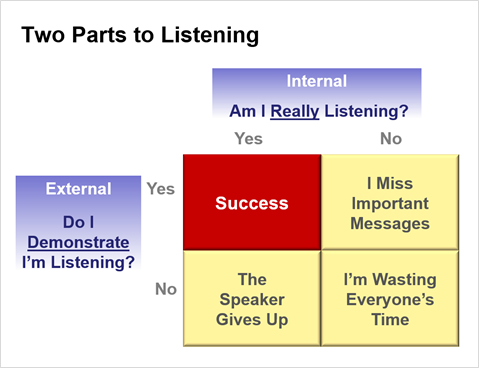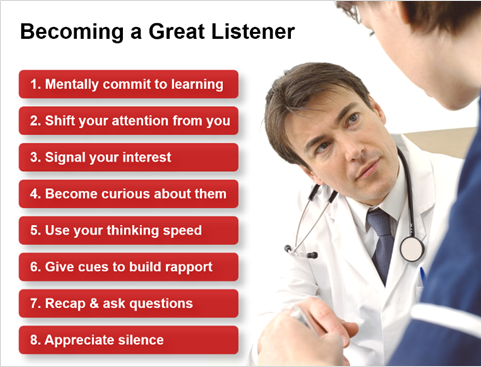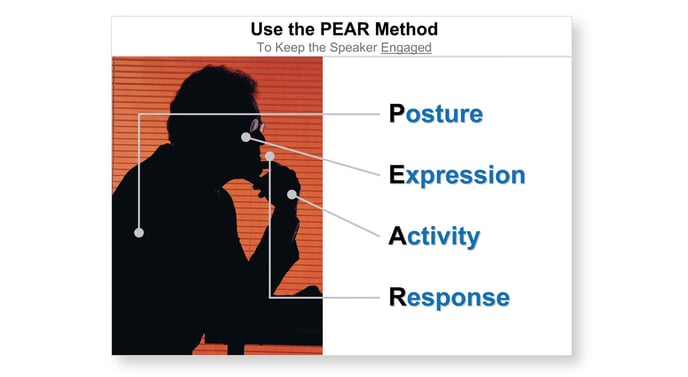There are two parts to great listening... 1) mentally prepare for active listening & 2) demonstrate you are really listening.
You have two listening goals for your customer calls. The first is to ensure you are really listening to what the customer is saying. The second is to demonstrate that you are listening to them.

You can learn how to get better at both in e-Learning Module 11: Listening Skills (at www.aimclientcenter.com > e-Learning). For now, let's begin with the mindset of really listening.
Am I really listening?
If you want to become a great listener, work on these 8 mindset practices:

- Before your meeting, mentally commit to learning. A wise man once said, “I am defeated and know it if I meet anyone from whom I cannot learn something.”
- Shift your attention from its natural resting place—yourself—to the other person. This means being OK with an entire conversation that’s not about you at all.
- Physically signal to the speaker that you are interested. Get rid of distractions, give them strong eye contact and position yourself to pay close attention to them.
- Become curious about what the speaker is saying. Don’t be satisfied with a superficial understanding… seek to understand why they are saying what they are saying.
- Use your thinking speed. You can think 2-4 times faster than the other person speaks. Don’t let your mind wander. Instead use this time to think hard about their message.
- Give cues to the speaker to build rapport… such as a few nods of the head and an affirming smile.
- Periodically recap the gist of their message, and ask pertinent questions. Recapping is especially helpful, because committing to this forces you to listen hard.
- Appreciate silence. If the speaker is thinking, don’t rush in to fill the void. This is especially important in a customer call, when you’re looking for deep thinking, not chatter.
Do I demonstrate I am listening?
Let’s say you’re doing a great job of listening. But do you look like you’re listening? Our PEAR method will help. To demonstrate you are truly listening, pay attention to these four behaviors:

- Posture: You say, “I’m listening” when you face the speaker directly, maintain an open position—without folded arms—and lean forward ever so slightly. You say, “I’m not interested” when you are slouched in your chair, have your hands behind your head, or cross your arms and legs.
- Expression: You say, “I’m listening” when you have a thoughtful, interested expression, and smile with affirming nods at appropriate times. You say, “I’m not interested” when your eyes wander around, have a bored expression, or fail to respond when the speaker says something that should evoke a sympathetic look or chuckle.
- Activity: You say, “I’m listening” with a quiet, still body, and keeping any gestures small and few… certainly not attention-getting. You say, “I’m not interested” with fidgeting and squirming, drumming fingers, glancing at your watch, or other distracting habits.
- Response: You say, “I’m listening” with affirming comments, such as, “OK… I see what you mean.” When you recap the essence of their message, this proves to them that you were listening. Insightful probing questions demonstrate you were listening to and thinking about what they were saying. You say, “I’m not interested” with an off-subject comment that doesn’t relate to their message. Placating comments like, “right… right… right” wear thin very quickly. And “that reminds me of… me” tells them who you are really interested in.
To see the impact these PEAR practices can have—both good and bad—check out the videos in e-learning module 4 of the SalesPrepTM system.

The SalesPrep system is offered as part of our Everyday VOC® training program.
Keywords: listening skills, great listening, PEAR, posture, expression, activities, response, signal interest, listening practices, gestures, fidget, placate, affirm, eye contact, looking at watch, Everyday VOC training, SalesPrep
